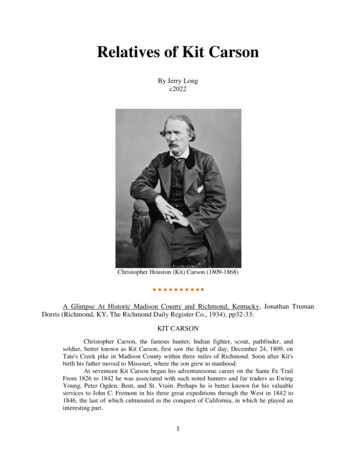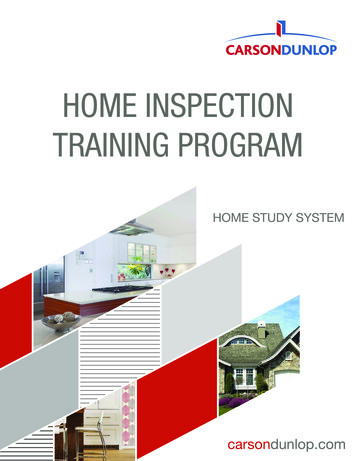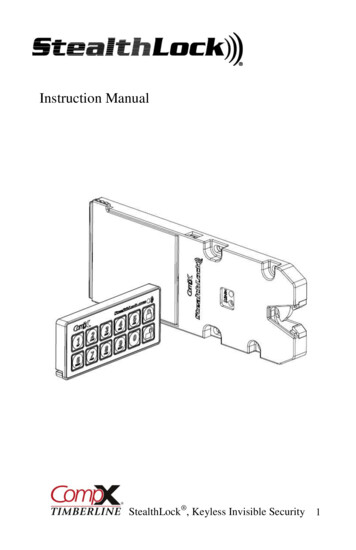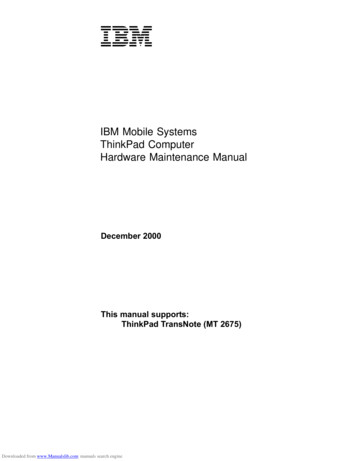
Transcription
FEDERAL UTILITY PARTNERSHIP WORKINGGROUP SEMINARMay 2-3, 2019San Diego, CAFort Carson Battery Energy Storage SystemRandy Smidt, UESC & ESPC Program Manager, U.S. ArmyHosted by:
Resilience through Alternative Financing Project Background:o Energy Savings Performance Contract (ESPC) – awarded AUG 2017o RFP released – JUL 2015o Scope: Battery Energy Storage (BESS) for peak shifting, EMCS, Lighting, Electric motors & drives Although this was done through ESPC, could be done through UESC as well. Consider and Use All Tools Available:ooooooUESCESPCUtilities Privatization (UP)Energy Resilience and Conservation Investment Program (ERCIP)Operations & Maintenance (O&M)Military Construction (MILCON) Not all projects will be suitable for all types of funding or contractingvehiclesFederal Utility Partnership Working GroupMay 2-3, 2019 San Diego, CA
Energy Resilience in the Army Energy and water resilience in support of mission readiness isthe driving priority. This project started before the pivot to the resilience focus. That was then, this is now:o 2015 – RFP for Carson ESPC releasedo 2015 – Army Energy Security & Sustainability (ES2) Strategy released – Informed Decisions,Assured Access, Build Resilience, Optimize Use, Drive Innovationo 2016 – DoDI 4170.11 revised, Army set up metrics to measure resilience, and did pilot for ISR-MC(resilience metrics)o 2017 - Army Energy Resilience Directive 2017-07 released: Critical Mission Support, AssuredAccess, Infrastructure Condition, System Operation. Full Army-wide roll-out of ISR-MC.o 2018 – Start Installation Energy & Water Plans (IEWP)Federal Utility Partnership Working GroupMay 2-3, 2019 San Diego, CA
Measuring Energy and WaterSecurity / ResilienceExample ISR-MC Installation QuestionsInstallation-level assessment of Energy andWater Security Attributes:- CRITICAL MISSION SUSTAINMENT (CMS):Critical mission continuity of operations for 14 days.- ASSURED ACCESS (AA): Dependable supply ofenergy and water needed to meet evolving missionrequirements during normal and emergencyresponse operations.- INFRASTRUCTURE CONDITION (IC):Infrastructure capable of on-site storage andflexible and redundant distribution networks toreliably meet mission requirements.- SYSTEM OPERATION (SO): Trained personnelconduct required energy and water security systemplanning, operations and sustainment activities.Federal Utility Partnership Working GroupMay 2-3, 2019 San Diego, CA
Ft Carson BESS Project Ft Carson put out an ESPC RFP through USACE-HNC that was fairly standard. Having been part of the SPIDERS JCTD, and already having on-post PV generation,they saw the potential for a BESS and included it in their discussions with the ESCO. Demand charges are half of their electric bill, so they were able to do BESS as aneconomically viable project, but it doesn’t quite get them to resilience on its own.Cost savings was driver, but resilience was a consideration. Pieces PV BESS microgrid? Next Step – OEI has now done aMicrogrid Feasibility Study. Using multiple tools to execute interrelated projects to get to resilience.Federal Utility Partnership Working GroupMay 2-3, 2019 San Diego, CA
Now Fully fleshed out Energy & Water Resilience framework to identify criticalmissions, identify resilience gaps, and plan for projects that bridge thegaps. We now include request for evaluation of resilience measures in our RFPs. Looking for pieces that DO cash flow and fit the appropriate contractingmethod. We are looking for your expertise on utility systems for ideas and insights.Federal Utility Partnership Working GroupMay 2-3, 2019 San Diego, CA
Questions?Randy SmidtUS Army HQOffice of the Assistant Chief of Staff for Installation Federal Utility Partnership Working GroupMay 2-3, 2019 San Diego, CA
Fort Carson Battery Energy Storage System Randy Smidt, UESC & ESPC Program Manager, U.S. Army Hosted by: FEDERAL UTILITY PARTNERSHIP WORKING GROUP SEMINAR . o 2015 - Army Energy Security & Sustainability (ES2) Strategy released - Informed Decisions, Assured Access, Build Resilience, Optimize Use, Drive Innovation .





![Smarter Battery Crack [2022-Latest]](/img/13/eliamari.jpg)




